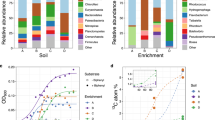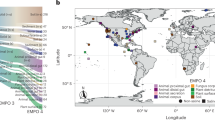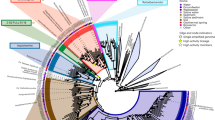Abstract
Microorganisms are responsible for driving the biogeochemical cycling of elements on Earth. Despite their importance and vast diversity1, the taxonomic identity of the microorganisms involved in any specific process has usually been confined to that small fraction of the microbiota that has been isolated and cultivated. The recent coupling of molecular biological methods with stable-isotope abundance in biomarkers has provided a cultivation-independent means of linking the identity of bacteria with their function in the environment2,3. Here we show that 13C-DNA, produced during the growth of metabolically distinct microbial groups on a 13C-enriched carbon source, can be resolved from 12C-DNA by density-gradient centrifugation. DNA isolated from the target group of microorganisms can be characterized taxonomically and functionally by gene probing and sequence analysis. Application of this technique to investigate methanol-utilizing microorganisms in soil demonstrated the involvement of members of two phylogenetically distinct groups of eubacteria; the α-proteobacterial and Acidobacterium lineages. Stable-isotope probing thus offers a powerful new technique for identifying microorganisms that are actively involved in specific metabolic processes under conditions which approach those occurring in situ .
This is a preview of subscription content, access via your institution
Access options
Subscribe to this journal
Receive 51 print issues and online access
$199.00 per year
only $3.90 per issue
Buy this article
- Purchase on Springer Link
- Instant access to full article PDF
Prices may be subject to local taxes which are calculated during checkout



Similar content being viewed by others
References
Hugenholtz, P., Goebel, B. M. & Pace, N. R. Impact of culture-independent studies on the emerging phylogenetic view of bacterial diversity. J. Bacteriol. 180, 4765–4774 (1998).
Hinrichs, K.-U., Hayes, J. M., Sylva, S. P., Brewer, P. G. & DeLong, E. F. Methane-consuming archaebacteria in marine sediments. Nature 398, 802– 805 (1999).
Boschker, H. T. S. et al. Direct linking of microbial populations to specific biogeochemical processes by 13C-labelling of biomarkers. Nature 392, 801–805 ( 1998).
Lidstrom, M. E. in The Prokaryotes (eds Balows, A., Trüper, H. G., Dworkin, M., Harder, W. & Schleifer, K.-H.) 431–445 (Springer, New York, 1992).
Hanson, R. S. & Hanson, T. E. Methanotrophic bacteria. Microbiol. Rev. 60, 439–471 (1996).
Meselson, M. & Stahl, F. W. The replication of DNA in Escherichia coli. Proc. Natl Acad. Sci. USA 44, 671–682 (1958).
Dedysh, S. N. et al. Isolation of acidophilic methane-oxidizing bacteria from northern peat wetlands. Science 282, 281– 284 (1998).
Barns, S. M., Takala, S. L. & Kuske, C. R. Wide distribution and diversity of members of the bacterial kingdom Acidobacterium in the environment. Appl. Environ. Microbiol. 65, 1731–1737 (1999).
Murrell, J. C. & Dalton, H. Methane and Methanol Utilizers (Plenum, New York, 1992).
Starr, M. P., Stolp, H., Trüper, H. G., Balows, A. & Schlegel, H. G. The Prokaryotes (Springer, Berlin, 1981).
Kishimoto, N., Kosako, Y. & Tano, T. Acidobacterium capsulatum gen. nov. sp. nov.: an acidophilic chemoorganotrophic bacterium containing menaquinone from acidic mineral environment. Curr. Microbiol. 22, 1–7 (1991).
Nogales, B., Moore, E. R. B., Abraham, W.-R. & Timmis, K. N. Identification of the metabolically active members of a bacterial community in a polychlorinated biphenyl-polluted moorland soil. Environ. Microbiol. 1, 199–212 ( 1999).
Rotthauwe, J.-H., Witzel, K.-P. & Liesack, W. The ammonia monooxygenase structural gene amoA as a functional marker: molecular fine-scale analysis of natural ammonia-oxidizing populations. Appl. Environ. Microbiol. 63, 4704–4712 (1997).
McDonald, I. R. & Murrell, J. C. The methanol dehydrogenase structural gene mxaF and its use as a functional gene probe for methanotrophs and methylotrophs. Appl. Environ. Microbiol. 63, 3218–3224 ( 1997).
Amann, R. I., Stromley, J., Devereux, R., Key, R. & Stahl, D. A. Molecular and microscopic identification of sulfate-reducing bacteria in multispecies biofilms. Appl. Environ. Microbiol. 58, 614–623 (1992).
Stein, J. L., Marsh, T. L., Wu, K. Y., Shizuya, H. & DeLong, E. F. Characterization of uncultivated prokaryotes: isolation and analysis of a 40-kilobase-pair genome fragment from a planktonic marine archaeon. J. Bacteriol. 178, 591– 599 (1996).
Lee, N. et al. Combination of fluorescent in situ hybridization and microautoradiography—a new tool for structure-function analyses in microbial ecology. Appl. Environ. Microbiol. 65, 1289– 1297 (1999).
Ouverney, C. C. & Fuhrman, J. A. Combined microautoradiography-16S rRNA probe technique for determination of radioisotope uptake by specific microbial cell types in situ. Appl. Environ. Microbiol. 65, 1746–1752 (1999).
Roslev, P. & Iversen, N. Radioactive fingerprinting of microorganisms that oxidize atmospheric methane in different soils. Appl. Environ. Microbiol. 65, 4064–4070 (1999).
Nold, S. C., Boschker, H. T. S., Pel, R. & Laanbroek, H. J. Ammonium addition inhibits 13C-methane incorporation into methanotroph membrane lipids in a freshwater sediment. FEMS Microbiol. Ecol. 29, 81–89 ( 1999).
Whittenbury, R., Phillips, K. C. & Wilkinson, J. F. Enrichment, isolation and some properties of methane-utilizing bacteria. J. Gen. Microbiol. 61, 205– 218 (1970).
Marmur, J. A procedure for the isolation of DNA from microorganisms. J. Mol. Biol. 3, 208–218 ( 1961).
Sambrook, J., Fritsch, E. F. & Maniatis, T. Molecular Cloning: a Laboratory Manual (Cold Spring Harbor Laboratory, Cold Spring Harbour, New York, 1989).
Moffat, A. J. & Boswell, R. C. Effect of tree species and species mixtures on soil properties at Gisburn Forest, Yorkshire. Soil Use and Management 6, 46–51 (1990).
Yeates, C. & Gillings, M. R. Rapid purification of DNA from soil for molecular biodiversity analysis. Lett. Appl. Microbiol. 27, 49–53 ( 1998).
DeLong, E. F. Archaea in coastal marine environments. Proc. Natl Acad. Sci. USA 89, 5685–5689 ( 1992).
Acknowledgements
We thank D. P. Kelly for discussion, C. B. Miguez for Methylobacterium extorquens strain AM155 and Forest Research for access to the study site. Funding was from the Natural Environment Research Council (NERC) EDGE Programme (S.R., P.I. and J.C.M.), NERC (N.R.P.) with further support from the European Union 4th Framework Programme (J.C.M.).
Author information
Authors and Affiliations
Corresponding author
Rights and permissions
About this article
Cite this article
Radajewski, S., Ineson, P., Parekh, N. et al. Stable-isotope probing as a tool in microbial ecology. Nature 403, 646–649 (2000). https://doi.org/10.1038/35001054
Received:
Accepted:
Issue Date:
DOI: https://doi.org/10.1038/35001054
This article is cited by
-
Ultra-sensitive isotope probing to quantify activity and substrate assimilation in microbiomes
Microbiome (2023)
-
Resource partitioning and amino acid assimilation in a terrestrial geothermal spring
The ISME Journal (2023)
-
Diverse electron carriers drive syntrophic interactions in an enriched anaerobic acetate-oxidizing consortium
The ISME Journal (2023)
-
Hyphosphere microbiome of arbuscular mycorrhizal fungi: a realm of unknowns
Biology and Fertility of Soils (2023)
-
HT-SIP: a semi-automated stable isotope probing pipeline identifies cross-kingdom interactions in the hyphosphere of arbuscular mycorrhizal fungi
Microbiome (2022)
Comments
By submitting a comment you agree to abide by our Terms and Community Guidelines. If you find something abusive or that does not comply with our terms or guidelines please flag it as inappropriate.



